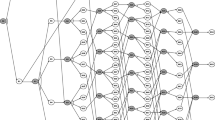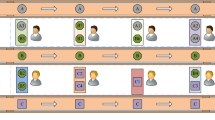Abstract
Waste electrical and electronic equipment (WEEE) not only occupies resources but also pollutes the environment. Disassembly and recycling of WEEE is an important part of sustainable manufacturing. However, the number of parts in WEEE is large and the relationship between parts is complex, which increases the difficulty of disassembly task planning. Therefore, this paper proposes a precedence graph based on associated parts and adopts a partial disassembly to reduce the number of disassembly tasks. To evaluate the green performance of the disassembly line, a partial disassembly line balancing model considering efficiency, profit, energy consumption, and hazard is proposed. Then, a multi-objective genetic simulated annealing algorithm is developed. To ensure the effectiveness of the algorithm, novel encoding, decoding, genetic operation, and simulated annealing operation based on problem constraints are designed. The proposed model and algorithm are applied to a waste refrigerator disassembly line in China, and the results show that the proposed algorithm is superior to the comparison algorithms. Compared with the original disassembly scheme, the new schemes have higher efficiency and profit, as well as lower energy consumption and hazard.















Similar content being viewed by others
References
Lee, C.-M., Woo, W.-S., & Roh, Y.-H. (2017). Remanufacturing: Trends and issues. International Journal of Precision Engineering and Manufacturing-Green Technology, 4(1), 113–125.
Um, J., & Suh, S.-H. (2015). Design method for developing a product recovery management system based on life cycle information. International Journal of Precision Engineering and Manufacturing-Green Technology, 2(2), 173–187.
Matsumoto, M., Yang, S., Martinsen, K., & Kainuma, Y. (2016). Trends and research challenges in remanufacturing. International Journal of Precision Engineering and Manufacturing-Green Technology, 3(1), 129–142.
Gungor, A., & Gupta, S. M. (2002). Disassembly line in product recovery. International Journal of Production Research, 40(11), 2569–2589.
Ding, L., Feng, Y., Tan, J., & Gao, Y. (2010). A new multi-objective ant colony algorithm for solving the disassembly line balancing problem. International Journal of Advanced Manufacturing Technology, 48(5–8), 761–771.
Mete, S., Cil, Z. A., Agpak, K., Ozceylan, E., & Dolgui, A. (2016). A solution approach based on beam search algorithm for disassembly line balancing problem. Journal of Manufacturing Systems, 41, 188–200.
Altekin, F. T., Kandiller, L., & Ozdemirel, N. E. (2008). Profit-oriented disassembly-line balancing. International Journal of Production Research, 46(10), 2675–2693.
Bentaha, M. L., Dolgui, A., Battaia, O., Riggs, R. J., & Hu, J. (2018). Profit-oriented partial disassembly line design: dealing with hazardous parts and task processing times uncertainty. International Journal of Production Research, 56(24), 7220–7242.
Agrawal, S., & Tiwari, M. K. (2008). A collaborative ant colony algorithm to stochastic mixed-model U-shaped disassembly line balancing and sequencing problem. International Journal of Production Research, 46(6), 1405–1429.
Wang, K., Li, X., & Gao, L. (2019). Modeling and optimization of multi-objective partial disassembly line balancing problem considering hazard and profit. Journal of Cleaner Production, 211, 115–133.
Wang, K., Li, X., Gao, L., & Garg, A. (2019). Partial disassembly line balancing for energy consumption and profit under uncertainty. Robotics and Computer-Integrated Manufacturing, 59, 235–251.
Zhang, L., Zhao, X., Ke, Q., Dong, W., & Zhong, Y. (2019). Disassembly line balancing optimization method for high efficiency and low carbon emission. International Journal of Precision Engineering and Manufacturing-Green Technology. https://doi.org/10.1007/s40684-019-00140-2.
Özceylan, E., Kalayci, C. B., Güngör, A., & Gupta, S. M. (2019). Disassembly line balancing problem: a review of the state of the art and future directions. International Journal of Production Research, 57(15–16), 4805–4827.
Avikal, S., Mishra, P. K., & Jain, R. (2014). A Fuzzy AHP and PROMETHEE method-based heuristic for disassembly line balancing problems. International Journal of Production Research, 52(5), 1306–1317.
Ren, Y., Zhang, C., Zhao, F., Tian, G., Lin, W., Meng, L., et al. (2018). Disassembly line balancing problem using interdependent weights-based multi-criteria decision making and 2-Optimal algorithm. Journal of Cleaner Production, 174, 1475–1486.
Kazancoglu, Y., & Ozturkoglu, Y. (2018). Integrated framework of disassembly line balancing with green and business objectives using a mixed MCDM. Journal of Cleaner Production, 191, 179–191.
McGovern, S. M., & Gupta, S. M. (2007). A balancing method and genetic algorithm for disassembly line balancing. European Journal of Operational Research, 179(3), 692–708.
McGovern, S. M., & Gupta, S. M. (2006). Ant colony optimization for disassembly sequencing with multiple objectives. International Journal of Advanced Manufacturing Technology, 30(5–6), 481–496.
Kalayci, C. B., & Gupta, S. M. (2013). A particle swarm optimization algorithm with neighborhood-based mutation for sequence-dependent disassembly line balancing problem. International Journal of Advanced Manufacturing Technology, 69(1–4), 197–209.
Kalayci, C. B., Hancilar, A., Gungor, A., & Gupta, S. M. (2015). Multi-objective fuzzy disassembly line balancing using a hybrid discrete artificial bee colony algorithm. Journal of Manufacturing Systems, 37, 672–682.
Tuncel, E., Zeid, A., & Kamarthi, S. (2014). Solving large scale disassembly line balancing problem with uncertainty using reinforcement learning. Journal of Intelligent Manufacturing, 25(4), 647–659.
Li, X., Lu, C., Gao, L., Xiao, S., & Wen, L. (2018). An effective multiobjective algorithm for energy-efficient scheduling in a real-life welding shop. IEEE Transactions on Industrial Informatics, 14(12), 5400–5409.
Pistolesi, F., Lazzerini, B., Mura, M. D., & Dini, G. (2018). EMOGA: A hybrid genetic algorithm with extremal optimization core for multiobjective disassembly line balancing. IEEE Transactions on Industrial Informatics, 14(3), 1089–1098.
Wang, K., Li, X., & Gao, L. (2019). A multi-objective discrete flower pollination algorithm for stochastic two-sided partial disassembly line balancing problem. Computers and Industrial Engineering, 130, 634–649.
Fang, Y., Liu, Q., Li, M., Laili, Y., & Truong, D., P (2019). Evolutionary many-objective optimization for mixed-model disassembly line balancing with multi-robotic workstations. European Journal of Operational Research, 276(1), 160–174.
Cong, L., Zhao, F., & Sutherland, J. W. (2017). Value recovery from end-of-use products facilitated by automated dismantling planning. Clean Technologies and Environmental Policy, 19(7), 1867–1882.
Li, W. D., Xia, K., Gao, L., & Chao, K. M. (2013). Selective disassembly planning for waste electrical and electronic equipment with case studies on liquid crystal displays. Robotics and Computer-Integrated Manufacturing, 29(4), 248–260.
Deb, K., Pratap, A., Agarwal, S., & Meyarivan, T. (2002). A fast and elitist multiobjective genetic algorithm: NSGA-II. IEEE Transactions on Evolutionary Computation, 6(2), 182–197.
Coello, C. A. C., Pulido, G. T., & Lechuga, M. S. (2004). Handling multiple objectives with particle swarm optimization. IEEE Transactions on Evolutionary Computation, 8(3), 256–279.
Deb, K., & Jain, H. (2013). An evolutionary many-objective optimization algorithm using reference-point-based nondominated sorting approach, part I: solving problems with box constraints. IEEE Transactions on Evolutionary Computation, 18(4), 577–601.
Zitzler, E., Laumanns, M., & Thiele, L. (2002). SPEA2: Improving the strength Pareto evolutionary algorithm for multiobjective optimization. Evolutionary Methods for Design, Optimisation and Control, 2002 (pp. 95–100), Barcelona, Spain.
Li, K., Wang, R., Zhang, T., & Ishibuchi, H. (2018). Evolutionary many-objective optimization: A comparative study of the state-of-the-art. IEEE Access: Practical Innovations, Open Solutions, 6, 26194–26214.
Zitzler, E., & Thiele, L. (1999). Multiobjective evolutionary algorithms: A comparative case study and the strength Pareto approach. IEEE Transactions on Evolutionary Computation, 3(4), 257–271.
Zitzler, E., Thiele, L., Laumanns, M., Fonseca, C. M., & Fonseca, V. G. D. (2003). Performance assessment of multiobjective optimizers: An analysis and review. IEEE Transactions on Evolutionary Computation, 7(2), 117–132.
Acknowledgements
This work is financially supported by the National Key Research and Development Program of China (Grant no. 2019YFB1704600), the National Natural Science Foundation of China (Grant nos. 51775216 and 51721092), and Program for HUST Academic Frontier Youth Team (Grant no. 2017QYTD04).
Author information
Authors and Affiliations
Corresponding author
Ethics declarations
Conflict of interest
The authors declare that they have no conflict of interest.
Additional information
Publisher's Note
Springer Nature remains neutral with regard to jurisdictional claims in published maps and institutional affiliations.
Rights and permissions
About this article
Cite this article
Wang, K., Li, X., Gao, L. et al. Modeling and Balancing for Green Disassembly Line Using Associated Parts Precedence Graph and Multi-objective Genetic Simulated Annealing. Int. J. of Precis. Eng. and Manuf.-Green Tech. 8, 1597–1613 (2021). https://doi.org/10.1007/s40684-020-00259-7
Received:
Revised:
Accepted:
Published:
Issue Date:
DOI: https://doi.org/10.1007/s40684-020-00259-7




